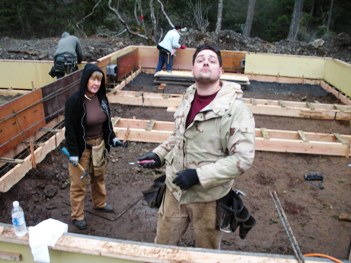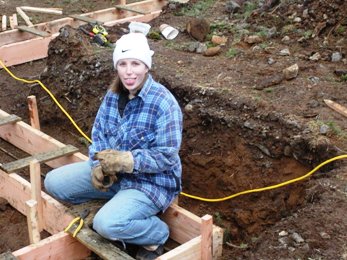by Cara Russell
Over three and a half years ago, I was standing in the empty kitchen of a brand-new home — and I mean brand new, with white walls, new cabinets, and appliances—every surface was clean and dust free.
There was paperwork in neat little piles along the kitchen counter, and I was signing my name over and over. A man with a friendly face handed me two small keys and said “Congratulations, you are now a homeowner.” I was just twenty-seven years-old.
I remember thinking, this isn’t really over. Anyone who has built their own home through Homes for Islanders (HFI), would be right here with me in thinking that here must be something else that needs to be finished—more papers to be signed, a ding in the wall that needed to be plastered, or the bathroom sink needs waterproofing, and the baseboard trim still has Frog tape on it.
But it was all done, really and truly done. Eight months of pre-qualifying and paperwork, and another 14 months of building and working together in teams with seven other families, in the rain, snow, and hot summer days.
Over the last four years Orcas Island has seen two small developments by Homes For Islanders (HFI): Woodland Estates located in Rosario; and North Beach Gardens located just outside of Eastsound off North Beach Road. Fourteen Orcas Island families have made their homes in these “sweat equity” developments.
The mission statement of HFI is “to work independently and with other housing organizations throughout San Juan County to provide all types of housing and housing assistance to low and moderate income residents, and other residents in need.”
HFI, started by the County Housing Advisory Board (now Housing Bank) has assisted in creating homes throughout the county, for a total of almost 100 families. It is a 501(c)(3) non-profit corporation funded by the U.S. Department of Agriculture through Rural Development.
Recently HFI has been working toward a third development on Orcas Island; it has identified several sites in Eastsound on relatively flat terrain. Six to eight houses would be placed on one of these lots. But HFI is struggling to build this third group of homes on Orcas Island, using the same formula that the otrganization has used over the years.
And what is the holdup? Presently, only three Orcas Islanders have applied for the do-it-yourself home where a minimum group requires at least six. HFI is trying to figure out why there are so few applying. Is there still a need for quality, affordable homes, built communally in the San Juan Islands?
North Beach Garden homeowner Bonnie Mahony and her family moved into their HFI Home over two and a half years ago. Mahony and her husband own a construction business; their household includes two daughters. Mahony commented on the subsidized mortgages offered through HFI. “Since we own our own business, our family doesn’t have the same paycheck every two weeks. In the winter, when the money is down, it’s nice to have a subsidized mortgage.”
A 502 Direct Loan Program provides construction loans to self-help participants. The construction loan converts to a permanent loan when the home is completed. This is where the 35+ hours of sweat equity comes in, as there is no down payment on the home. The loans run for 33 years, and the payments are subsidized as low as one percent interest depending upon the family income.
If a family’s income goes up, the interest rate will be adjusted upward, just as the interest rate would be adjusted downward if a family’s income goes down. Homeowners never pay more than one-third of their income toward their mortgage.
There is no question that building your own HFI home is a commitment. While keeping a regular job, the homeowners also must put in 35+ required hours each week (half of the weekly hours must be met by the head of household) building not just their own home, but helping build everyone’s home in the project. And no one moves in until all the houses are ready to occupy.
The process can be lengthy. Prequalifying can take months- the construction process on average takes up to 15 months. “At some point in the process every homeowner asks themselves if this is all worth it. But one day the endless building is over, everyone goes into their own homes, and there you are with a finished, brand-new home that is yours,” said Mahony.
The self-help program is hugely cost effective for the home owner. “HFI does the shopping, gets quantity discounts, and works with a good set of plans. And it is more cost effective since you are saving labor costs, taxes and markups,” said Campbell.
HFI Homes Offer:
- Two-, three- and four-bedroom houses
- Individual choices in flooring, countertops and appliance colors
- Household garage
- Household garden
HFI Homeowners need to start with:
- Steady income
- Good credit (HFI will work with people who have poor credit scores)
- Willingness to work 35+ hours a week to build the home. (This can include 50% of the recruited labor of friends and family.)
HFI works closely with the applicant throughout the entire process; from assistance in applying for the Rural Housing loan to construction budgeting and instructions and supervision during every phase of the construction process.
HFI Architect John Campbell believes that it’s important to emphasize that HFI builds good standard homes: simple, functional, and comfortable. “HFI designs are nice standard houses. One of the ways things get to be standard is that they work in the long run, and they are cost effective. I built my own house, and what isn’t standard is a real pain in the neck,” Campbell said.
Any Orcas Islander looking for affordable housing and willing to work for it is encouraged to call Homes for Islanders at 370-5944, or visit the site. https://www.homesforislanders.org/
**If you are reading theOrcasonian for free, thank your fellow islanders. If you would like to support theOrcasonian CLICK HERE to set your modestly-priced, voluntary subscription. Otherwise, no worries; we’re happy to share with you.**









